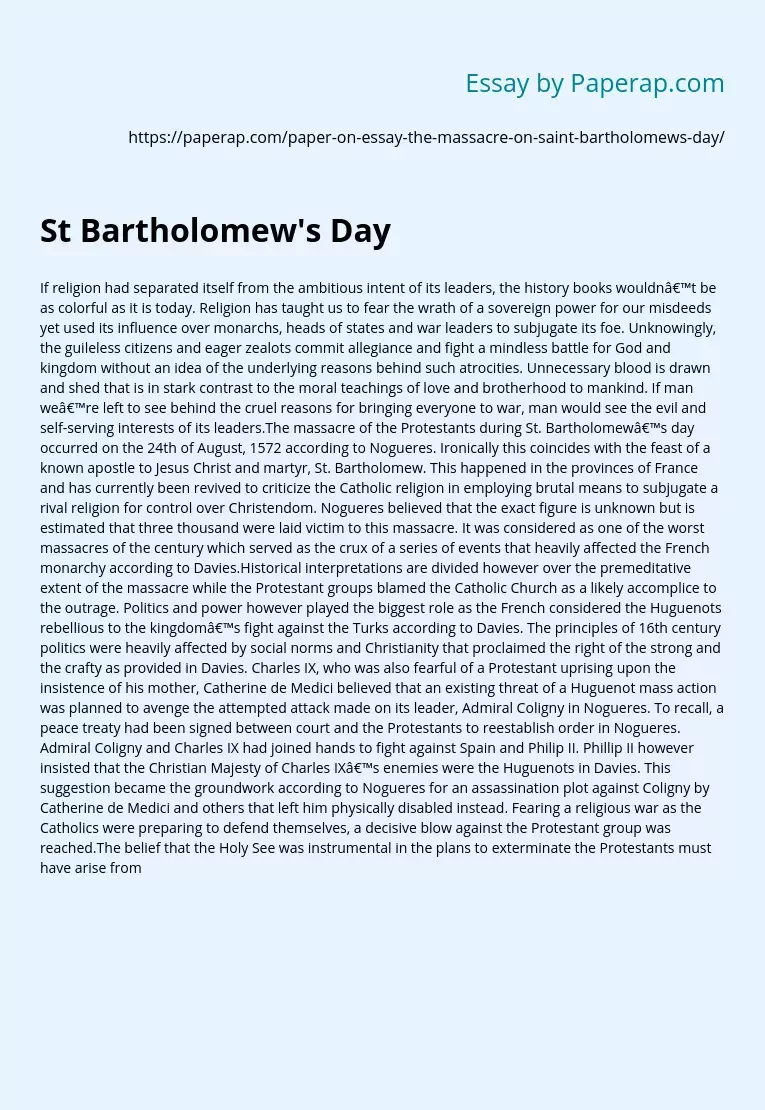St Bartholomew's Day
If religion had separated itself from the ambitious intent of its leaders, the history books wouldn’t be as colorful as it is today. Religion has taught us to fear the wrath of a sovereign power for our misdeeds yet used its influence over monarchs, heads of states and war leaders to subjugate its foe. Unknowingly, the guileless citizens and eager zealots commit allegiance and fight a mindless battle for God and kingdom without an idea of the underlying reasons behind such atrocities.
Unnecessary blood is drawn and shed that is in stark contrast to the moral teachings of love and brotherhood to mankind. If man we’re left to see behind the cruel reasons for bringing everyone to war, man would see the evil and self-serving interests of its leaders.The massacre of the Protestants during St. Bartholomew’s day occurred on the 24th of August, 1572 according to Nogueres. Ironically this coincides with the feast of a known apostle to Jesus Christ and martyr, St.
Bartholomew. This happened in the provinces of France and has currently been revived to criticize the Catholic religion in employing brutal means to subjugate a rival religion for control over Christendom. Nogueres believed that the exact figure is unknown but is estimated that three thousand were laid victim to this massacre. It was considered as one of the worst massacres of the century which served as the crux of a series of events that heavily affected the French monarchy according to Davies.Historical interpretations are divided however over the premeditative extent of the massacre while the Protestant groups blamed the Catholic Church as a likely accomplice to the outrage.
Politics and power however played the biggest role as the French considered the Huguenots rebellious to the kingdom’s fight against the Turks according to Davies. The principles of 16th century politics were heavily affected by social norms and Christianity that proclaimed the right of the strong and the crafty as provided in Davies. Charles IX, who was also fearful of a Protestant uprising upon the insistence of his mother, Catherine de Medici believed that an existing threat of a Huguenot mass action was planned to avenge the attempted attack made on its leader, Admiral Coligny in Nogueres. To recall, a peace treaty had been signed between court and the Protestants to reestablish order in Nogueres. Admiral Coligny and Charles IX had joined hands to fight against Spain and Philip II. Phillip II however insisted that the Christian Majesty of Charles IX’s enemies were the Huguenots in Davies. This suggestion became the groundwork according to Nogueres for an assassination plot against Coligny by Catherine de Medici and others that left him physically disabled instead. Fearing a religious war as the Catholics were preparing to defend themselves, a decisive blow against the Protestant group was reached.The belief that the Holy See was instrumental in the plans to exterminate the Protestants must have arise from Catherine’s plans to have the marriage of her daughter Margaret to the Protestant prince Henry of Navarre solemnized in Paris to bring the Protestant leaders there for the purpose of murdering them in Davies. In reality, a royal marriage between a Catholic and a Protestant was arranged to cement the original peace treaty signed by both parties. However the same marriage faced heavy opposition by diehard Catholics, Phillip II of Spain and the pope. It was further believed that the Catholic advisers along with Catherine de Medici forced the weak king. Others believed that France’s hatred of the Huguenots was exploited to put pressure to the king and his mother to curb any possibility of a riot in Davies. Catherine’s actions were actually impelled by a belief that his son would be acting powerlessly alone after her divisive masterminding of Coligny’s attempted murder and to repair whatever damage she had done beforehand.The Catholic Church’s involvement in the plot to massacre the Protestants in Paris was further enhanced in letters written to Rome by the papal nuncio in Paris and a relative to Catherine, Salviati. Salviati had written to Rome that the “Queen will rap the Admiral’s knuckles if he goes too far” (French: donnera à l’Admiral sur les ongles in Nogueres). His next letter to the Vatican though belied any knowledge and his utter disbelief of the massacre. Pope Gregory XIII who ordered jubilation after the massacre and Vasari to paint the Vatican apartments to commemorate the fall of the Huguenots as related in Davies equally proved their involvement. “Hugonottorum strages” in Nogueres described in a medal how the conspirators were slaughtered. Regardless of explanation, such behavior is unacceptable despite claims that jubilation was held to rejoice on the safety of the French Catholics in the kingdom. The prince of the Catholic Church as instigator of goodwill and peace should proclaim whatever is right despite denominational differences.Gregory XIII’s judgment on Maurevel, Coligny’s assassin and his refusal to accept him established the Holy See’s eagerness to rectify itself from its previous behavior. Fair judgment based on spiritual morals however can no longer assume the innocent claims of jubilation over the massacre. This goes to explain that any church for that matter as it is controlled by humans can be subjected to the human behavior of greed and power which has been the root of all religious conflicts.
St Bartholomew's Day. (2019, Dec 05). Retrieved from https://paperap.com/paper-on-essay-the-massacre-on-saint-bartholomews-day/

